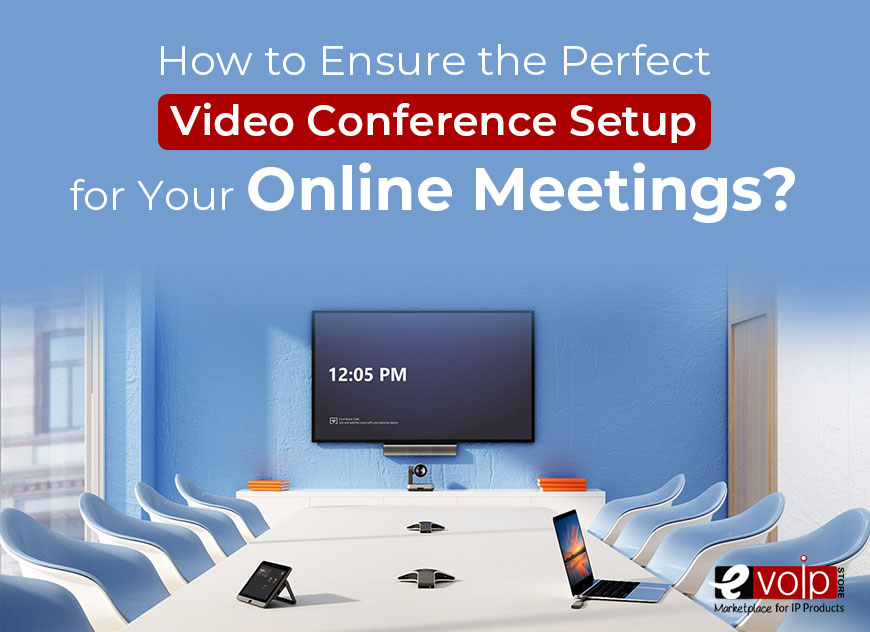How to Ensure the Perfect Video Conference Setup for Your Online Meetings?

Although video conferencing was gaining due importance even in pre-pandemic times, the emergence of Covid-19 resulted in most companies opting for remote working overnight. As a result, video conferencing witnessed a tremendous increase in its use and applicability all across the globe. Today, the amount and type of work people are handling from home via a video conference device is surprising. And not just that, both the vendors and the end-users have gained a lot of insights into its working and usability, resulting from the pandemic experience.
Whether you are a newbie in video conferencing, looking for an excellent experience, or someone who wants to upgrade their existing system, here are some best practices for a video conferencing system in India to help you be more productive and efficient in conducting or attending online meetings through video conferencing.
Hardware Requirements for Video Conferencing
The foremost thing you require for joining an online meeting with excellent video and audio quality is the hardware. To ensure effective face-to-face communications with the best video conferencing system, you must invest in suitable hardware. The two most crucial hardware requirements for video conferencing are a headset and microphone and a video conferencing camera.
However, before understanding the use of these hardware appliances, here’s a pro-tip: Test out your equipment before joining the meeting. Why? Because it will help you avoid any problems or interruptions during the session.
-
Headset and Microphone
The level of noise in your surroundings can significantly affect the audio quality of your video conference. While attending meetings from your home or any other space, you need to make sure that there is no noise to pose interruptions and distractions during the session. Whereas, in a situation where you cannot avoid the noise in the background, your best option can be to invest in the right microphone and headset.
However, do not forget to check the compatibility of the headset and microphone with your IP video conference system. You can even check if the vendor has provided recommendations about using some specific hardware with their platform.
-
Video Conferencing Camera
Video conferencing aims to make you feel connected and mimic real-life interactions even from a distance. The video quality plays an essential role in ensuring that you feel like you are together in the same room with other participants. With your computer’s OS settings, check how other participants are seeing you through your camera. If your video seems grainy or pixelated, it’s time to upgrade your webcam!
Apart from the hardware requirements, video conferencing also requires some platform requirements to be put into place. Read on to find out.
Platform Requirements for Video Conferencing
There is a wide array of options of video conferencing platforms available. Whichever be the best video conference system for you and your company, each platform comes with its own compatibility requirements, which include:-
-
Internal Meetings of the Organisation
While conducting meetings within the organisation, every panel member needs to understand the software compatibility of the platform used by your company. Knowing how many participants your platform supports, which app is required for using the platform, the browser version, and OS upgrades can be beneficial to avoid issues during the meeting. You should check all this information beforehand to avoid any last-minute hassles.
-
Conducting External Meetings
All the requirements needed for internal meetings are also applicable to external meetings. Ensure that you know the IP video conference system requested by them to conduct the meeting and understand which features you would like to be accessible to your guests. In addition, it is best to communicate all the hardware and software requirements to avoid any technical glitches during the session. Moreover, you need to share access codes beforehand for letting them join the meeting.
Role of Network Bandwidth In Video Conferencing
Network bandwidth plays a crucial role in influencing your online experience. Whichever platform you choose, the audio and video quality will only meet your expectations when the network bandwidth has the capabilities that your platform requires. A slow network can pose difficulties like video lag, buffering, video freezing, and other delays. Some ways to avoid these connectivity issues in your office and homework setup include:-
-
Office Setup
You can easily connect with the IT team to troubleshoot the problems faced while connecting to an online meeting in an office setting. Do not forget to confirm the resolution of the issue before conducting another meeting.
-
Home Setup
When you are working from home, you can try the following ideas to resolve the connectivity issues:-
- Try relocating your setup close to the Wi-Fi router.
-
Avoid turning on your video, if possible, in that particular meeting.
-
Adjust the bandwidth resolution settings on your device.
-
Close applications that use high bandwidth.
Summing Up!
Video conferencing is witnessing high-paced growth and becoming the most effective communication and collaboration tool. However, to achieve the maximum benefits, it is essential to have a suitable video and audio solution in place for your video conferencing device. So keep an eye out for any upgrades that your video conferencing platform may require.
